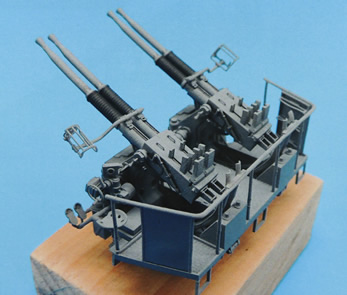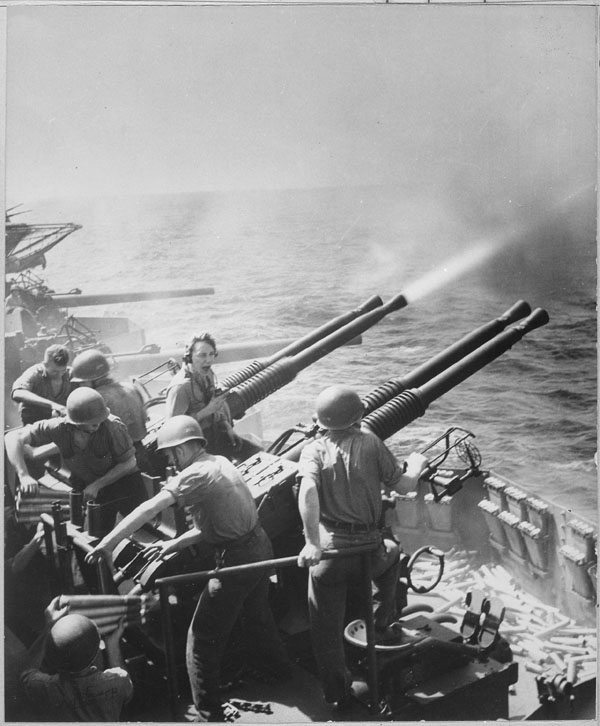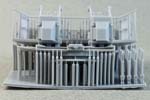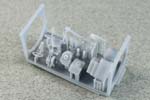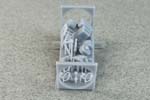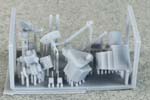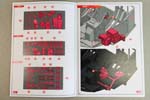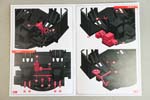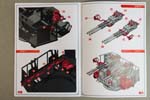40MM Bofors Quad Gun
MK.2
Black Cat Models. 1/72nd scale. 3D Printed Resin
Reviewed by Devin Poore, July 2021
Ubiquitous on US Navy warships during the Second World War, the 40mm Bofors was initially designed and built by the Swedes in 1930. In 1940 a copy was smuggled into the United States aboard the liner American Legion. Once the weapon had been tested at the Dahlgren, Virginia, weapons station and verified to be as good of quality as claimed, the guns were put into production, initially by The York Safe and Lock Co., but most US models were made by Chrysler and the Naval Gun Factory in Washington, D.C. The first systems were installed on US Navy warships starting in mid-1942, initially on new construction, and then retrofitted to other warships as they returned to the yards for repair and refit.
The weapon was used by all branches of the US military, most of the Allied powers, and captured units were even fielded by the German army, making it the most-produced and deployed anti-aircraft gun of the war. Available in single, dual, and quadruple mounts, the US Navy installed them on everything from small ships such as PT boats, submarines, and landing craft, all the way up to battleships and aircraft carriers.
The quadruple-mount, the subject of this model, was manned by two gunners, and between four and eight loaders, depending on the specific situation. Rate of fire was technically 160 rounds per minute, but the manual loading procedures and the number of men required for them, meant that if a mount got off 100 rounds a minute it was doing very well. The gun served throughout the war in the US Navy, while afterwards it saw gradual replacement over the years by the 3" mount and other upgraded weapons systems. While none are still in use in by the US today, the gun is still in service in various militaries around the world.
I have a lot of references on WWII ships and their weapons, including John Campbell's "Naval Weapons of World War Two", and there's even more now available on the internet, but I have been unable to find a single, simply-illustrated, plan or measurement that shows the size of a quad 40mm mount. What I did do, however, was measure the gun barrels and receiver in this kit, and compare those measurements with 40mm mounts I have in 1/350th scale and 1/700th scale from various manufacturers. In all cases, the measurements were within a millimeter or two in 1/72nd scale, which to me means that if this kit isn't properly sized, then no aftermarket sets of this mount are properly sized. That means either they're all correct, or if not, they all will read the same to the modeler's eye, which is as good as you can get in my book.
The kit comes in a cardboard box with two blister packs inside. The larger pack has the gun loader platform with trunnion assembly, and the gun barrels. The largest piece in the kit is the loader platform, with attached gun trunnions, ejector chute channels, and safety railing. This piece has a large amount of support material, which is necessary for the level of detail. Consult the instructions before beginning to cut it free from the supports, as there are suggestions on how to best proceed and not damage the fine railings. Also included on this print assembly are continuations of the casing chute assembly that attach to the front of the mount. Detail is very fine and impressive, with special note being to the subdued and scale appearance of the diamond plate surface of the loaders' platforms. There are some print artifacts on the flat surfaces of the trunnion mounts, but they are minimal.
The gun barrels come in two pieces, each as twin assemblies. Ammo chutes are nicely hollow, as are the muzzles. Recoil springs, grab handles, and other features are well-rendered and in-scale.
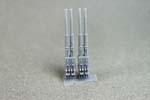
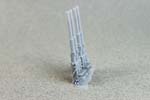
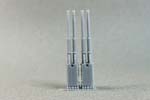
The other blister pack contains four individual printed rafts of detail parts. The larger two rafts contain the larger pieces, which include transmission boxes, gunners' seats, hand cranks, and other small bits. Pay attention to these pieces during assembly, because even though the seats and other pieces look identical, they are in fact mirrored, to fit to their specific side of the mount. The seats are realistically thin with sharp lightening holes. Other details such as small pipes, dials, and conduit boxes are quite small, so consult the instructions before removal, to make sure that what you're cutting is indeed a support, and not a piece of the model.
The other two rafts include the smaller detail pieces, including the sights, the gears of the elevation mechanisms, clips of ammunition, foot rungs, and more. Some of these may be challenging to remove, as they're quite tightly packed on the raft, but careful work from the outside-in with sharp sprue cutters should prove successful.
Instructions are in color, printed on three 8.5" x 11" sheets, that are folded and stapled in booklet format. The first two pages are an inventory of parts; the illustrations for the loader platform assembly and the guns are quite helpful in showing the kit parts in red and the support material in gray, clearly indicating what needs to be cut away. The remainder of the instructions deal with assembly, showing location of the items mostly in perspective view, so that position and alignment should be easily deduced.
The final page of the instruction is titled Paint Guide, which are two color photos of a finished model. Mention is made that the color of these mounts depended on the ship's color at the time. The platforms, railings and most components were typically painted the same color as the bulkheads near them, the recoil springs were typically black. The guns were generally painted, but could be bare metal, or a combination of the two. Refer to reference photos.
There's been a rise in ship's weapons kits lately in the injected molded model companies, most notably Takom doing shipboard gun mounts and missile launchers. It's nice to see United States Navy mounts in the larger scales. The printing quality is up to the usual standards we've come to expect from Black Cat, with fine details, adequate supports, and minimal layer artifacts. Some of those print artifacts are in prominent areas, such as the trunnion faces, but with 3D printing, at least for now, there's no way to get around them on items with flat surfaces and sharp corners. What there is should disappear under a coat of primer or with minimal sanding. Extra care will have to be taken to remove supports from very fine features, such as safety railings, dials and gauges, but it's nothing someone with a couple of resin or fine injected molded kits under their belt will have problems with.
This is a very unique and cool kit. Something different that offers a lot of possibility for those who build large scale ship kits, or those looking to build a mini-diorama or vignette. Highly recommended.
References:
Campbell, N. J. M. Naval Weapons of World War Two, Naval Institute Press, 1985.
Friedman, Norman. US Naval Weapons, Conway, 1983.
